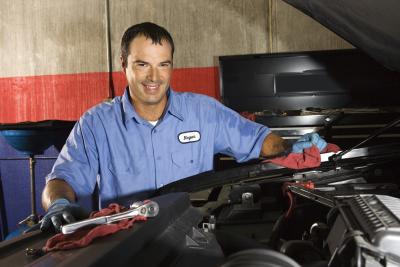
Many vehicles come with cast iron manifold stock. This material is generally fairly reliable, but does have some problems. Cast iron manifolds often contain a number of small imperfections in their thick walls that can develop into stress risers (cracks) over the thousands of intense heat cycles the manifolds must endure. Fortunately, the fix is usually simple, if a bit labor-intensive.
Aside from whatever hand tools you're going to need to remove the manifold from the vehicle, you're going to need a grinder, and an oxyacetylene torch or arc welder. You could use a MIG welder for the procedure, but the focus here is to rejoin the original material, not to fill the crack in with weld material.
Removal of the stock manifold is fairly straightforward and doesn't vary much from vehicle to vehicle. Simply unbolt the exhaust crossover pipe, and remove all of the exhaust manifold bolts from the head. Prepare the manifold by scraping away all of the old exhaust manifold gasket material from both it and the head.
To ensure that you're actually joining the material, and not just adding more, you're going to need to bevel the crack before welding. Identify the crack, and mark it with a white marker pencil to make for an easier job. Use a grinder with the thinnest, smallest-diameter grinding wheel that you can find, and carefully remove about one sixteenth of an inch of material from the crack. Depending on the location and thickness of the material, you may not want to go that deep, but do so if you can.
Set the arc welder or oxyacetylene torch to the lowest temperature that you can and still melt the material. See Resources at the bottom of this article for a video on silver soldering with a torch. While welding, heat the area evenly to avoid hot-spotting the manifold. This will reduce warpage and cracking, always a danger when welding on cast iron this thick. When you are confident that you've done all the welding you can, allow the manifold to air-cool, and grind the weld flush. Never artificially cool material this thick with water or oil; it will almost certainly irreparably warp and crack.
To finish the repair, use a high-temperature metal filler such as those made by Permatex of Alvin chemicals. Some of these are single-stage "squeeze-and-apply" products, while others are two-part epoxies similar to JB Weld. Mix about two tablespoons of epoxy together and smear it over the weld. Allow to set for two to four hours, and sand it flat.
A word of warning: If the crack is in the exhaust flange itself, do not weld on the mating surface. Weld around the outside of the flange, and fill the mating-surface side crack with epoxy. Be aware also that any kind of welding might cause the exhaust manifold to warp, so you may need take the finished manifold to a machine shop to have the mating surface milled flat.